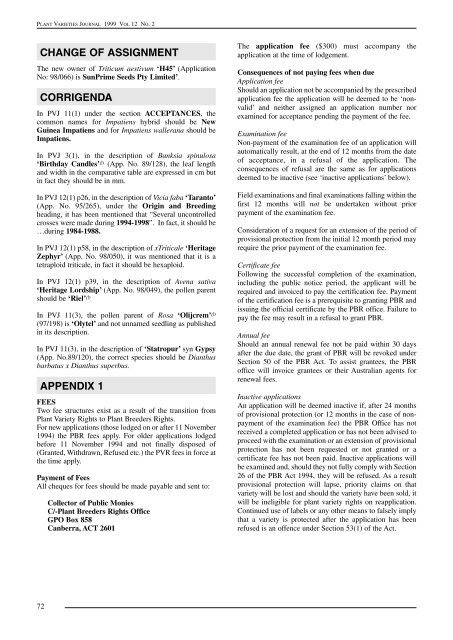56. Volume 12- Number 2 - IP Australia
56. Volume 12- Number 2 - IP Australia
56. Volume 12- Number 2 - IP Australia
Create successful ePaper yourself
Turn your PDF publications into a flip-book with our unique Google optimized e-Paper software.
PLANT VARIETIES JOURNAL 1999 VOL <strong>12</strong> NO. 2<br />
CHANGE OF ASSIGNMENT<br />
The new owner of Triticum aestivum ‘H45’ (Application<br />
No: 98/066) is SunPrime Seeds Pty Limited’.<br />
CORRIGENDA<br />
In PVJ 11(1) under the section ACCEPTANCES, the<br />
common names for Impatiens hybrid should be New<br />
Guinea Impatiens and for Impatiens wallerana should be<br />
Impatiens.<br />
In PVJ 3(1), in the description of Banksia spinulosa<br />
‘Birthday Candles’ A (App. No. 89/<strong>12</strong>8), the leaf length<br />
and width in the comparative table are expressed in cm but<br />
in fact they should be in mm.<br />
In PVJ <strong>12</strong>(1) p26, in the description of Vicia faba ‘Taranto’<br />
(App. No. 95/265), under the Origin and Breeding<br />
heading, it has been mentioned that “Several uncontrolled<br />
crosses were made during 1994-1998”. In fact, it should be<br />
…during 1984-1988.<br />
In PVJ <strong>12</strong>(1) p58, in the description of xTriticale ‘Heritage<br />
Zephyr’ (App. No. 98/050), it was mentioned that it is a<br />
tetraploid triticale, in fact it should be hexaploid.<br />
In PVJ <strong>12</strong>(1) p39, in the description of Avena sativa<br />
‘Heritage Lordship’ (App. No. 98/049), the pollen parent<br />
should be ‘Riel’ A<br />
In PVJ 11(3), the pollen parent of Rosa ‘Olijcrem’ A<br />
(97/198) is ‘Olytel’ and not unnamed seedling as published<br />
in its description.<br />
In PVJ 11(3), in the description of ‘Statropur’ syn Gypsy<br />
(App. No.89/<strong>12</strong>0), the correct species should be Dianthus<br />
barbatus x Dianthus superbus.<br />
APPENDIX 1<br />
FEES<br />
Two fee structures exist as a result of the transition from<br />
Plant Variety Rights to Plant Breeders Rights.<br />
For new applications (those lodged on or after 11 November<br />
1994) the PBR fees apply. For older applications lodged<br />
before 11 November 1994 and not finally disposed of<br />
(Granted, Withdrawn, Refused etc.) the PVR fees in force at<br />
the time apply.<br />
Payment of Fees<br />
All cheques for fees should be made payable and sent to:<br />
Collector of Public Monies<br />
C/-Plant Breeders Rights Office<br />
GPO Box 858<br />
Canberra, ACT 2601<br />
The application fee ($300) must accompany the<br />
application at the time of lodgement.<br />
Consequences of not paying fees when due<br />
Application fee<br />
Should an application not be accompanied by the prescribed<br />
application fee the application will be deemed to be ‘nonvalid’<br />
and neither assigned an application number nor<br />
examined for acceptance pending the payment of the fee.<br />
Examination fee<br />
Non-payment of the examination fee of an application will<br />
automatically result, at the end of <strong>12</strong> months from the date<br />
of acceptance, in a refusal of the application. The<br />
consequences of refusal are the same as for applications<br />
deemed to be inactive (see ‘inactive applications’ below).<br />
Field examinations and final examinations falling within the<br />
first <strong>12</strong> months will not be undertaken without prior<br />
payment of the examination fee.<br />
Consideration of a request for an extension of the period of<br />
provisional protection from the initial <strong>12</strong> month period may<br />
require the prior payment of the examination fee.<br />
Certificate fee<br />
Following the successful completion of the examination,<br />
including the public notice period, the applicant will be<br />
required and invoiced to pay the certification fee. Payment<br />
of the certification fee is a prerequisite to granting PBR and<br />
issuing the official certificate by the PBR office. Failure to<br />
pay the fee may result in a refusal to grant PBR.<br />
Annual fee<br />
Should an annual renewal fee not be paid within 30 days<br />
after the due date, the grant of PBR will be revoked under<br />
Section 50 of the PBR Act. To assist grantees, the PBR<br />
office will invoice grantees or their <strong>Australia</strong>n agents for<br />
renewal fees.<br />
Inactive applications<br />
An application will be deemed inactive if, after 24 months<br />
of provisional protection (or <strong>12</strong> months in the case of nonpayment<br />
of the examination fee) the PBR Office has not<br />
received a completed application or has not been advised to<br />
proceed with the examination or an extension of provisional<br />
protection has not been requested or not granted or a<br />
certificate fee has not been paid. Inactive applications will<br />
be examined and, should they not fully comply with Section<br />
26 of the PBR Act 1994, they will be refused. As a result<br />
provisional protection will lapse, priority claims on that<br />
variety will be lost and should the variety have been sold, it<br />
will be ineligible for plant variety rights on reapplication.<br />
Continued use of labels or any other means to falsely imply<br />
that a variety is protected after the application has been<br />
refused is an offence under Section 53(1) of the Act.<br />
72

















